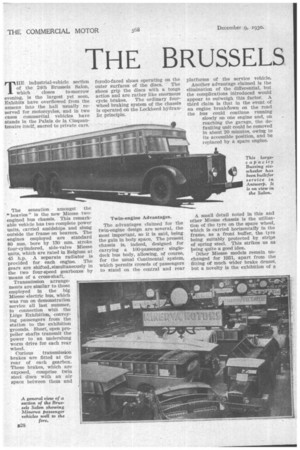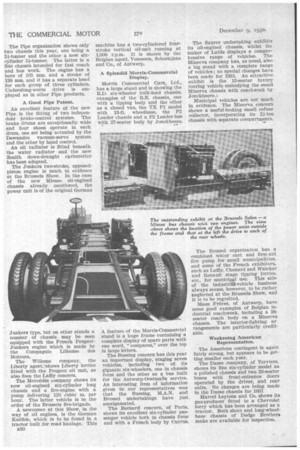THE BRUSSELS SALON
Page 46

Page 47

Page 48

If you've noticed an error in this article please click here to report it so we can fix it.
TEE industrial-vehicle section of the 24th Brussels Salon, which closes to-morrow evening, is the largest yet seen. Exhibits have overflowed from the annexe into the hall usually reserved for motorcycles, and in two cases commeraial vehicles have stands in the Palais de la Cinquantenaire itself, sacred to private cars.
The sensation amongst the " heavies" is the new Miesse two • engined bus chassis. This remarkable vehicle has two complete power units, carried amidships and slung outside the frame on bearers. The engines employed are standard 80 mm. bore by 130 mm. stroke four-cylindered, side-valve Miesse units, which are rated in Belgium at 45 h.p. A separate radiator is provided for each engine. The gears are shifted, simultaneously in the two four-speed gearboxes by means of a cross-shaft.
Transmission arrangements are similar to those employed in the big Miesse electric bus, which was run on demonstration service all last summer, in connection with the Liege Exhibition, conveying passengers from the station to the exhibition grounds. Short, open propeller shafts transmit the power to an underslung worm drive for each rear wheel.
Curious transmission brakes are fitted at the rear of each gearbox. These brakes, which are exposed, comprise twin steel discs with an air space between them and ferodo-faced shoes operating on the outer surfaces of the discs. The shoes grip the discs with a tongs action and are rather like enormous cycle brakes. The ordinary fourwheel braking system of the chassis is operated on the Lockheed hydraulic principle.
Twin-engine Advantages.
The advantages claimed for the twin-engine design are several, the most important, so it is said, being the gain in body space. The present chassis is, indeed, designed for carrying a 100-passenger singledeck bus body, allowing, of course, for the usual Continental system, which permits crowds of passengers to stand on the central and rear platforms of the service vehicle.
Another advantage claimed is the elimination of the differential, but the complications introduced would appear to outweigh this factor. A third claim is that in the event of an engine brealdlown on the road the bus could continue running slowly on one engine and, on reaching the garage, the defaulting unit could be removed in about 20 minutes, owing to its accessible position, and be replaced by a spare engine.
A small detail noted in this and other Miesse chassis is the utilization of the tyre on the spare wheel, which is carried horizontally in the frame, as a front buffer, the tyre being suitably protected by strips of spring steel. This strikes us as being quite a good idea.
Other Miesse models remain unchanged for 1931, apart from the fitting of much wider brake drums, but a novelty is the exhibition of g
21-ton chassis arranged for running on producer gas, the gas machine adopted being the Bellay, which employs charcoal fuel. A good feature of the layout is the sharp angle at which the finned gas-cooling pipes traversing the chassis are canted in order to dispose of the products of condensation.
Another exhibit comprises a five-tonner with a Junkers oil engine.
Ransomes, Sims and Jefferies, Ltd., shows a sixwheeled trolley-bus of the Continental single-deck type. This vehicle is similar in general design to the fourwheeled Ransomes trolley
buses already giving good service in Liege, but has greater carrying capacity. This exhibit, which attracts a great deal of attention, is nominally a 60-passenger bus, but, in practice, it will probably carry about 75 when the platforms are crowded.
Advances in Coachwork.
The improvement in Belgian industrial coachwork noticed during the past two or three years is strikingly confirmed in the present Salon. Belgium, like France, was slow in taking up the idea of public passenger transport by road, but having at last adopted it, the movement is making phenomenal progress and regular town-to-town services are becoming general, whereas in France they still hardly exist.
In this connection the firm of Jonckheere deserve special men
tion, as they are responsible for r. large percentage of the passenger bodies exhibited. An example of Jonckheere's latest work is a 21sea ter front-entrance and rearexit bus body' with three-ply panelling. This body weighs only 1,015 kilos. and has been adopted for vehicles engaged on a number of local services in Belgium.
Jonckheere coach bodies particularly noted include a 36-seater with a sliding roof, mounted on a G.M. chassis, and a similar body with ultramodern interior decoration in futurist inlaidwood designs, on a Minerva chassis. The firm show also a number of pretty and practical bodies, mounted on various makes of chassis, for high-class tourist work, the bodies accommodating from 10 to 15 passengers. At the present time this particular type of body is enjoying a great vogue on the Continent, and the many examples that are available at this exhibition afford an interesting comparison of the different ideas put forward by various designers. The Pipe organization shows only two chassis this year, one being a 31-tonner and the other a new sixcylinder 5i-banner. The latter is a fine chassis intended for fast coach and bus work. The engine has a bore of 105 ram. and a stroke of 130 mm. and it has a separate head for each group of three cylinders. Underslung-worm drive is employed as in other Pipe products.
A Good Pipe Patent.
An excellent feature of the new Pipe is the fitting of two independent brake-control systems. The brake drums are exceptionally wide and four shoes operate in each drum, one set being actuated by the Dewandre vacuum-servo system and the other by hand control.
An oil radiator is fitted beneath the water radiator and the new Zenith down-draught carburetter has been adopted.
The Junkers two-stroke, opposedpiston engine is much in evidence at the Brussels Show. In the case of the new Miesse oil-engined chassis already mentioned, the power unit is of the original German Junkers type, but on other stands a number of chassis may be seen equipped with the French PeugeotJunkers engine which is made by the Compagnie Lilleoise des Moteurs.
The Willeme company, the Liberty agent,' shows Liberty lorries fitted with the Peugeot oil unit, as also does the Laftly concern.
The Mercedes company shows its new oil-engined six-cylinder long chassis and a fire-engine, with a pump delivering 120 cubic m. per hour. The latter vehicle is to the order of the Brussels fire-brigade.
A newcomer at this Show, in the way of oil engines, is the German Kaelble, which is to be found in a tractor built for road haulage. This n30 machine has a two-cylindered fourstroke vertical oil-unit running at 1,000 r.p.m. It is shown by the Belgian agent, Venesoen, Schoonjans and Co., of Antwerp.
A Splendid Morris-Commercial Display.
Morris Commercial Cars, Ltd., has a large stand and is showing the R.D. six-wheeler bulk-load chassis, examples of the R.E. chassis, one with a tipping body and the other as a closed van, the TX P1 model with 13-ft. wheelbase, the P2 Leader chassis and a P2 Leader bus with 27-seater body by Jonckheere.
A feature of the Morris-Commercial stand is a huge frame containing a complete display of spare parts with one word, " comparez," over the top in large letters. The Bussing concern has this year an important display, staging seven vehicles, including two of its gigantic, six-wheelers, one in chassis form and the other as a bus built for the Antwerp-Oostmalle service. An interesting item of information given to our representatives was that the Bussing, M.A.N. and Brossel undertakings have just amalgamated.
The Bernard concern, of Paris, shows its excellent six-cylinder passenger vehicle both in chassis form and with a French body by Currus. The Sourer undertaking exhibits its oil-engined chassis, whilst thE maker of Latils displays a comprehensive range of vehicles. The Minerva company has, as usual, also a big stand with a complete range of vehicles ; no special changes have been made for 1931. An attractive exhibit is the 15-seater luxury touring vehicle embodying the small Minerva chassis with coachwork by Jonckheere. i Municipal vehicles are not much in evidence. The Minerva concern shows a useful-looking small refuse collector, incorporating its 2i-ton chassis with separate compartments.
The Brossel organization has a combined water cart and first-aid fire pump for small municipalities, and some of the French exhibitors, such as Lally, Chenard and Walcker and Renault stage tipping lorries, etc., for municipal use. This side of the industria-vehicle business always seems, however, to be rather neglected at the Brussels Show, and it is to be regretted.
1VIaes Freres, of Antwerp, have some good examples of Belgian industrial coachwork, including a 38seater coach body on a Minerva chassis. The interior-lighting al' rangements are particularly creditable.
Weakening American Representation.
The American contingent is again fairly strong, but appears to be getting smaller each year.
The Dasse company, of Verviers, shows. its fine six-cylinder model as a polished chassis and two 20-seater buses with front-entrance doors operated by the driver, and rear exits. No changes are being made in the Dasse chassis for 1931 Marcel Leytens and Co. shows its gas-producer fitted to a Chevrolet lorry which has been arranged as a tractor. Both short and long-wheelbase chassis of Dodge Brothers make are available for inspection.




































































































